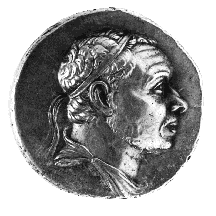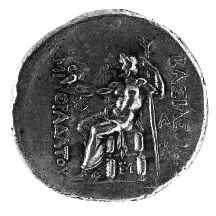



(46) Pontos, Mithradates III - AR tetradrachm, c. 200 B.C., 16.55
g. (inv. 93.011).
Obverse: Draped and diademed bust of Mithradates III r.
Reverse: Zeus seated l., with eagle in r. and scepter in
l.; star and crescent in 1. field; monograms in r. field and beneath seat;
![]()
![]() : of King Mithradates.
: of King Mithradates.
Provenance: Harlan Berk, 1989.
Bibliography: O. Mørkholm, Early Hellenistic
Coinage from the Accession of Alexander to the Peace of Apamea (336-188
B.C.) (Cambridge 1991) 131.
The kingdom of Pontos on the Black Sea probably issued its first coins,
gold staters of the type issued by Alexander, under Mithradates II, who
was in power from c. 255 to 220 B.C. His successor, Mithradates III (c.
220-185 B.C.), introduced the first distinctive Pontic coins, tetradrachms
with his portrait on the obverse. The portrait is one of the most striking
in all of Hellenistic coinage. Although it must have been made by a Greek
die-cutter, there is not a trace of the typical Hellenization that characterizes
the coin portraits of most Hellenistic rulers. The presumably realistic
head, with its receding hairline, deeply furrowed brow, drooping moustache,
and close-cropped beard, is that of a barbarian proud of his non-Greek blood.
Most of the inhabitants of Pontos were of Iranian descent, and although
Mithradates himself married a Seleukid, the country for the most part remained
stubbornly resistant to outside influence.
In sharp contrast, the reverse depicts a seated Zeus clearly inspired by
the reverses of Alexander's tetradrachms (see no. 41),
although even here Mithradates has added something of his own, the star
and crescent in the left field that will mark Pontic gold and silver coinage
to the end.
C.L.L.



All contents copyright (c) 1996.
Lawrence University
All rights reserved.